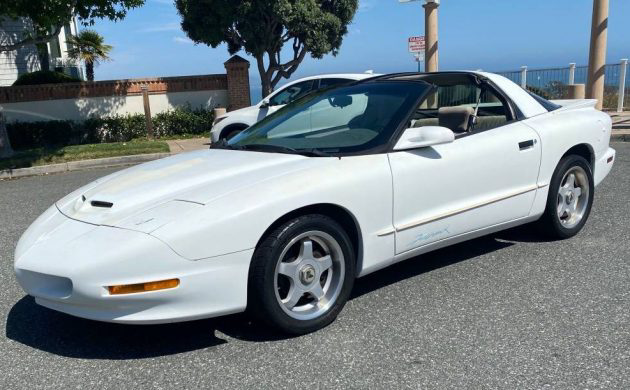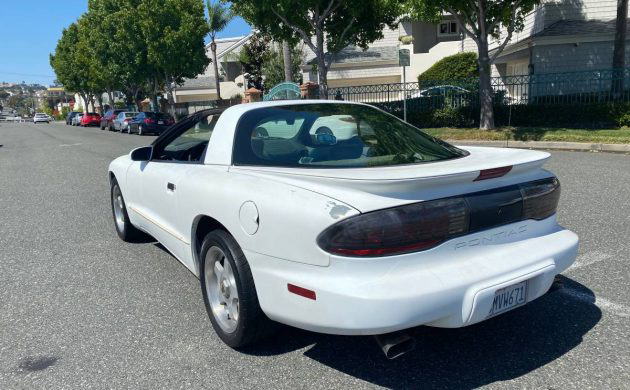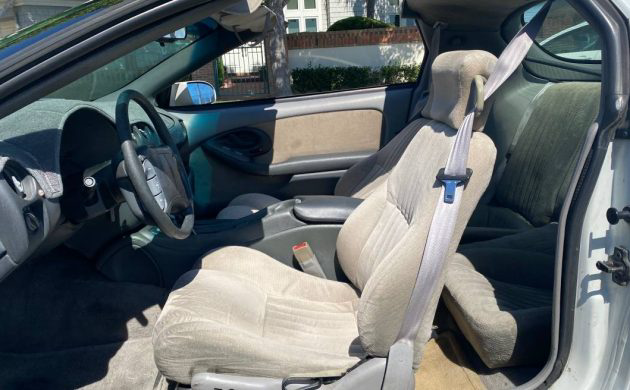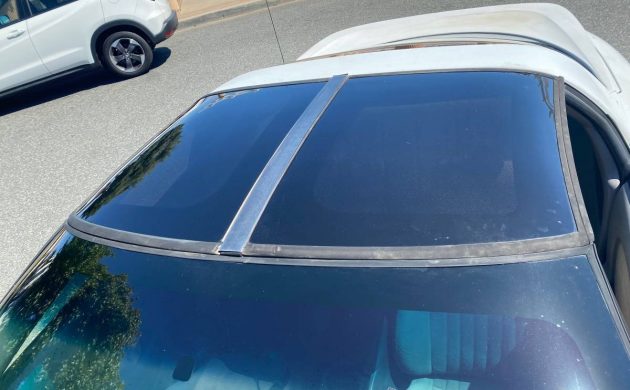This 1994 Pontiac Firebird Firehawk seems like an absolute performance bargain for anyone who can live with rough cosmetics or has access to a paintbooth. Built in limited numbers and featuring a variety of desirable performance upgrades, the Firehawk is a somewhat forgotten about high-performance option that offers buyers an alternative to the now-pricey Fox body Cobras that are selling for $30K or more in preserved condition. This example is simply a victim of the California sun rather an outright neglect, and is listed here on craigslist with a cheap asking price of $4,000. Thanks to Barn Finds reader Pat L. for the find.
As you can see on the left rear corner, the original finish is heavily damaged. The seller is upfront about this, noting the clearcoat is essentially gone and the paint is down to bare metal in places. He affirms there’s no history of accident damage, and based on many of the original Firehawk features still present and accounted for and the wholly decent interior, it seems likely this Firehawk really is just a victim of the California sun. It still wears its Firehawk-specific wheels but it’s hard to say whether the finish has oxidized. The seller notes it has 140,000 original miles, which shows the Firehawk is one of the few that has actually been used as opposed to treated like a showcar.
And that in and of itself is pretty cool, as many limited production muscle cars tend to be kept under cover and hardly see the light of day. While this Firehawk will not necessarily ever be enormously collectible as a result of the level of use its seen, they all can’t be time capsules. The interior does look decent on this example, but it also shows us just how far GM has come in terms of the quality of the cabins that now come standard. To think this was likely a fairly expensive purchase when new and all you got were cloth bucket seats, acres of gray plastics, and possibly one of the ugliest steering wheels ever found in a modern passenger car – well, it’s a good thing we’ve come so far in terms of standard features.
The Firehawk comes with T-top roof panels, which I don’t believe came as standard equipment. This Firehawk also appears to have the lightweight composite hood with the functional cold air induction system, and the Firehawk graphics remain affixed to the doors in perfectly 90s teal. It came standard with 300 b.h.p. and 300 lbs-ft of torque, courtesy of the LT1. Aside from an optional 3″ exhaust, you could also order a high-end Bilstein suspension system from the factory, but no word on whether this car has those features. The seller notes it will need brakes and tires soon, but he has recently replaced the radiator, spark plugs, and wires, and given it a fresh oil change. Is this well-used Firehawk a performance bargain?






Seems like a good project to me, and I think this is a low entry price for something interesting and collectable (at least as far as early 90s cars are concerned). Firehawks have always been pretty rare, and they were a real performance upgrade back in the day, not just an appearance package.
Besides, things go in cycles in car collecting — as the generations change, so does the nostalgia. 90s nostalgia is right around the corner, and this would be a great car to experience it with.
You are right, these are closing in on their 30th birthday. We’ve seen the appreciation of prices before, first for the 70’s F-body’s then for the 80’s Pony cars, these are next in line. If you want a 4th gen LT1 powered Firebird you’d have a hard time finding a better starting point than a Firehawk. It is little wonder the ad is now gone.
Steve R
Not exactly. It depends on the impact the car caused on the public at the time. There’s a lot of third and fourth gen camaros and firebirds around, which gives us a plenty of room to keep pushing these wonders of engineering through daily life. I always said that these ones can clock easily 400 kph in bonneville and they often did while laughing at expensive imported cars made 10-20 years after these were released. Still some of the best basic options for daily driving, cheap parts and lots of recipes for tuning.
I always thought that nostalgia worked in opposite way regarding material things. As you hit 50 years old in the 21st century, you really need a very modern 2000-something Monte Carlo coupe to give you the maximum of confort and minimal problems. And then you can give to your kid that little 1965 Impala fastback that has nothing but a few buttons and a simple mechanic system so he can learn from it. Nostalgia evokes concepts from different eras and I don’t want to start a competition to see who’s better, because the current generation is always the better in terms of progress.
People in future will remember when Tesla was one very innovative brand created by a crazy millionaire called Elon Musk, but be aware of product crash if you want to start a collection. Usually in the next 10 years a new car just loses value, between 10-20 it stands in a limbo, from 20-30 it get’s the collector’s value but at 30-40 it simply crashed. The product at this point is so obsolete that only a few very rare surviving models are valued. The rest is junk.
Kirk,
The major problem with modern cars is their reliance on computers. Those devices will not last 50 years. Electric vehicles have a problem with batteries. They don’t last long and quickly become obsolete. People who buy modern cars as investments and those who will buy them in the future better get used to the idea of pushing them around.
The 3rd gen 1992 SLP Firehawk is an F-body legend. It had a crazy modified L98 that made 350 (advertised) horsepower, the 6-speed manual from the Corvette, and a whole host of suspension upgrades, and even an optional roll cage. It ran the 1/4 in the low 13s and hit 60 in the mid-4s.
Of course, it cost more than double the price of a base Formula and only 25 were built. This car is the Holy Grail of 3rd gens and would cost a small fortune to acquire, if you could even find one for sale.
The original Firehawk was a no-expense spared work of art and almost bankrupted SLP. So for 1993, they toned it down considerably. This version, while not a tape and stripe package, was much more mundane. It had a fiberglass ram air hood, a slightly stiffer front anti-roll bar, shorter and lower rear control arms, and new Panhard rod. It also had 17 x 9.0-inch aluminum wheels with P275/40ZR17 Firestone Firehawk SZs, and Firehawk decals and emblems. The engine and transmission were left rock stock to avoid emissions testing issues.
SLP produced the Firehawk for the entire fourth generation model run except for 1998 and it sold pretty well – about 1,500 per year. As to whether it’s a performance bargain, at $4,000 it would be hard to go wrong. However, these 4th gen Firehawks are not particularly rare and the 1996-02 WS6 Firebirds (and 1996-02 SS Camaros) have very similar equipment. So they’re really not all that special to be honest, except the very rare 1997 LT4 and 2002 “Blackwing” versions. But they’re certainly a step up over a standard Formula or Trans Am and can be had for a reasonable cost.
Didn’t GM switch to the LS1 in 98 as well as change the front sheet metal? Several of my friends have 98 and newer F-body’s, one just recently totaled his 98 SE in the rain, he replaced it with a 2000 SS. None would ever consider an LT1 powered F-body. That seems to be as pronounced of dividing line as is normally seen from generational split, such as 1st gen to 2nd gen and so forth.
Steve R
Yes that’s correct. For 1998, the front clips on both the Camaro and Firebird were changed and the LS1 replaced the LT1 on the Z28, Formula, Trans Am and B4C cars.
Surprise, surprise, post has been deleted. For that price, it was a no brainer to buy that car.